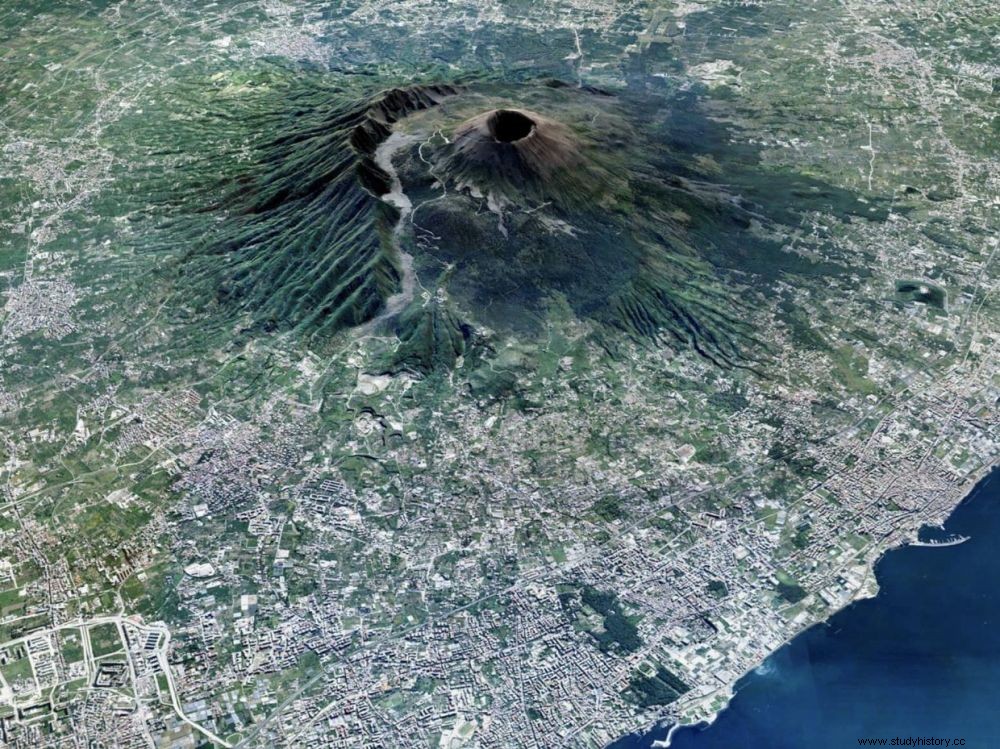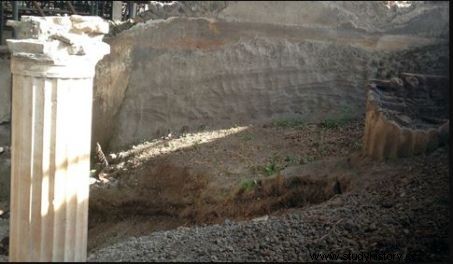A new study and numerical simulations of the eruption of Vesuvius in 79 CE reveal the magnitude of the pyroclastic currents and the tragic impact of their effects on the population of Pompeii.

3D view of Vesuvius and the inhabited areas on its slopes.
The scenario of the last moments of life of the inhabitants of Pompeii, following the fatal eruption of Vesuvius in October 79 AD. J.C, keeps getting clearer. And fifteen minutes would have been enough to kill by asphyxiation all the occupants of the small city of Campania. This is the estimated duration of the pyroclastic currents or "fiery clouds" which then descended on the city. During the eruption, an avalanche of solid and gaseous products suddenly descended from the flanks of the neighboring volcano, saturating the air with unbreathable powdery ash. A fluid and burning mass several tens of meters high – according to the letters of the ancient author Pliny the Younger (Correspondance , VI-16), we spoke at the time of a cloud in the shape of an umbrella pine - then wiped out all living beings, humans and animals, in less than 17 minutes.
Pyroclastic density currents
This is according to a new study published in the journal Scientific Reports by the Department of Earth Sciences and Geo-environment of the University of Bari (Italy), in collaboration with the National Institute of Geophysics and Volcanology (INGV) of Italy and the British Geological Survey of Edinburgh (Scotland) .
The scenario of the last moments of life of the inhabitants of Pompeii, following the fatal eruption of Vesuvius in October 79 AD. J.C, keeps getting clearer. And fifteen minutes would have been enough to kill by asphyxiation all the occupants of the small city of Campania. This is the estimated duration of the pyroclastic currents or "fiery clouds" which then descended on the city. During the eruption, an avalanche of solid and gaseous products suddenly descended from the flanks of the neighboring volcano, saturating the air with unbreathable powdery ash. A fluid and burning mass several tens of meters high – according to the letters of the ancient author Pliny the Younger (Correspondance , VI-16), we spoke at the time of a cloud in the shape of an umbrella pine - then wiped out all living beings, humans and animals, in less than 17 minutes.
Pyroclastic density currents
This is according to a new study published in the journal Scientific Reports by the Department of Earth Sciences and Geo-environment of the University of Bari (Italy), in collaboration with the National Institute of Geophysics and Volcanology (INGV) of Italy and the British Geological Survey of Edinburgh (Scotland) . "The objective of this work was to develop a model to try to understand and quantify the impact of pyroclastic flows (PDC) on the inhabited area of Pompeii" , said Roberto Isaia, researcher at the Vesuvian Observatory of the INGV, in a press release.
 Pyroclastic deposits in the inhabited area of Pompeii. ©INGV-OV
Pyroclastic deposits in the inhabited area of Pompeii. ©INGV-OV
Pyroclastic Density Currents (PDCs) are a devastating phenomenon associated with certain types of volcanic eruption. These are flows of a mixture of volcanic gases, water vapor and solid particles (pumice stones or lapilli, slag etc) flowing at ground level, along the slopes of volcanoes like an avalanche in the mountains. The speed reaches several hundred km/h, some having been measured at 700 km/h. "With the studies carried out on the site of Pompeii, we developed a mathematical model that allowed us to carry out numerical simulations. From these, we were able to model pyroclastic density currents and estimate their effects. The main result is that their passage took place for 10-20 minutes , a duration to which little attention had been paid until then", says Roberto Isaia. Resisting exposure to hot air between 200 and 250°C cannot exceed 2 to 5 minutes, and the presence of inhalable burning fine ashes considerably reduces this survival time. "The duration of exposure therefore plays a major role in determining the impact of pyroclastic currents on humans, which had not been quantified until now" , continues the scientist. A model that could be applied to other active volcanoes in the world.

Eruption of Vesuvius by moonlight, 1774. Work of Pierre-Jacques Volaire (Le Chevalier Volaire) (1729-1802). © Electa/Leemage/AFP
Deathflow
The eruption of Vesuvius began in the heart of autumn, on October 24, 79, with a thin bed of fine ash. Then an explosive phase followed, resulting in the formation of an eruptive column 25 km high. Favored by stratospheric winds, a volcanic plume dispersed towards the southeast of the region. The Roman towns and villages located along this axis of dispersion were then covered with lapilli (pumice stones) and ash, up to 4.5 meters thick in Pompeii - the famous "layer of death". "This explosive phase would have ended with the resumption of the eruption within a few hours later, the high column abruptly collapses generating destructive pyroclastic flows" , explain the authors. Fifteen minutes in the heart of this cloud of incandescent ashes which must have seemed endless to the inhabitants of Pompeii, making any escape impossible for those who had not yet left the city.
